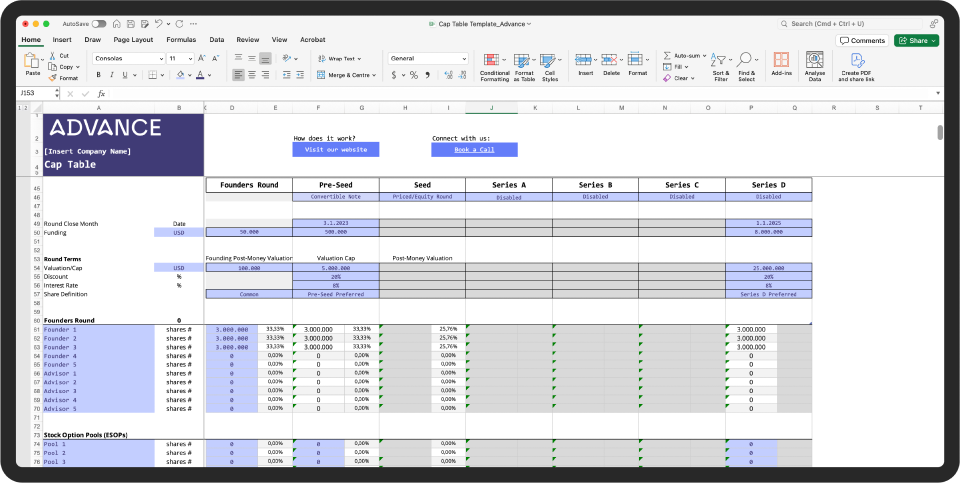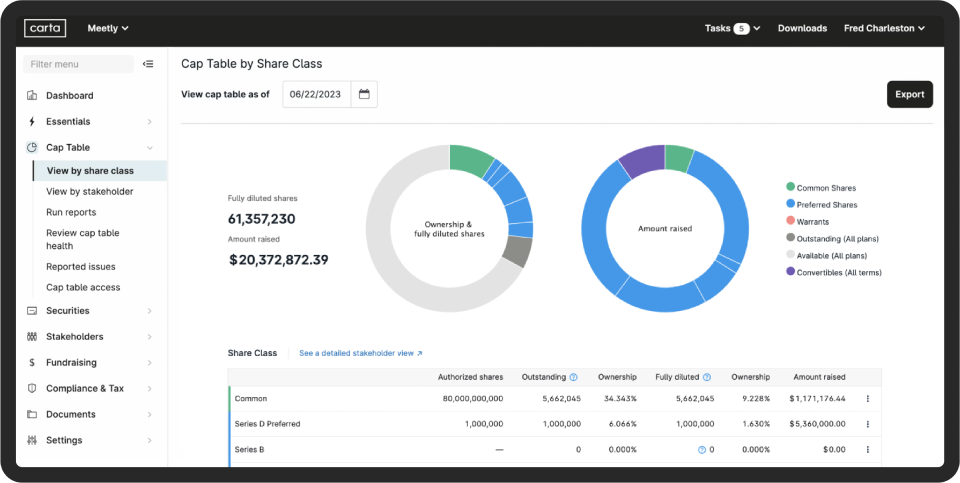Download our CAP template
We invite you to download our comprehensive CAP table template. If you encounter any questions while using the template or need assistance tailoring it to your specific needs, don't hesitate to reach out to our team of experts. We're here to support you.
What is a CAP table
A capitalization table, commonly known as a CAP table or startup cap table, is a detailed spreadsheet or document that outlines the equity ownership in a company. It provides a clear picture of who owns what percentage of the company, including all types of securities such as common shares, preferred shares, options, warrants, and convertible notes.
The CAP table serves as a living document that evolves with your company, reflecting changes in ownership as you issue new shares, grant options, or raise additional funding. It’s an essential tool for founders, investors, and employees to understand the company’s ownership structure and the potential impact of future equity-related decisions.
Why CAP tables
matter for startups
We offer a range of team experiences, each designed to address specific needs and objectives:
01
Equity Management
It helps you track and manage all equity-related transactions, ensuring you have a clear understanding of your company’s ownership structure.
02
Fundraising
When seeking investment, potential investors will want to see your CAP table to understand the current ownership breakdown and assess how their investment will fit into the picture.
03
Employee Compensation
As you grant stock options or other equity incentives to employees, the CAP table helps you manage these allocations and understand their impact on overall ownership.
04
Valuation
The CAP table is a crucial component in determining your company’s valuation, especially during fundraising rounds.
05
Exit Planning
When considering an exit strategy, such as an acquisition or IPO, the CAP table provides essential information about how proceeds would be distributed.
06
Legal Compliance
An accurate CAP table helps ensure compliance with securities laws and regulations.
Key components
of a CAP table
A comprehensive CAP table typically includes the following information:
Shareholder names
Types of securities held (common shares, preferred shares, options, etc.)
Number of shares or options held by each shareholder
Percentage ownership for each shareholder
Date of issuance or grant
Price paid per share or exercise price for options
Vesting schedules for options or restricted stock
Liquidation preferences for preferred shares
Anti-dilution provisions
Conversion rights
CAP table
structure and vocabulary
A cap table is a complex document that requires a deep understanding of various terms and concepts. In this section, we will break down the key terms and concepts that startup founders need to know to effectively manage their cap table.
Key terms and concepts for startup founders
Authorized shares
The total number of shares that a company is authorized to issue. This number is set in the company’s charter and can be increased with shareholder approval.
Fully diluted shares
The total number of outstanding shares, including all potential shares that could be issued through options, warrants, and convertible securities. This provides a complete picture of the company’s potential equity structure.
Outstanding shares
The total number of shares currently owned by all shareholders, excluding any shares that could be issued in the future.
Dilution
The reduction in ownership percentage that occurs when new shares are issued. This is a critical concept for founders to understand, especially during funding rounds.
Pre-money valuation
The valuation of a company before a new funding round. This figure is used to determine the price per share for new investors.
Post-money valuation
The valuation of a company after a new funding round, which includes the new capital raised. This helps in understanding the impact of the new investment on the company’s overall value.
Common stock
Common stock is the most straightforward form of equity, representing ownership in the company. Shareholders typically have voting rights and may receive dividends, though they are last in line during liquidation events.
Preferred stock
Preferred stockholders have a higher claim on assets and earnings than common stockholders. They often receive dividends before common stockholders and have priority in the event of liquidation. Preferred stock can also come with additional rights, such as anti-dilution provisions and conversion rights.
Stock options
Stock options are a popular form of employee compensation, giving employees the right to purchase shares at a set price, known as the exercise price. Options typically come with a vesting schedule, meaning employees earn the right to purchase shares over time.
Convertible notes
Convertible notes are a form of short-term debt that converts into equity, usually at a future funding round. They are often used in early-stage financing because they allow startups to delay valuation discussions until a later date.
Warrants
Warrants are similar to stock options but are typically issued to investors as part of a financing deal. They give the holder the right to purchase shares at a specific price and are often used to sweeten investment deals.
How to create a
CAP table
Building from scratch (Spreadsheet method)
This method involves creating your CAP table using a spreadsheet program like Microsoft Excel or Google Sheets

Pros
Full control over the structure and layout
No additional costs
Suitable for very early-stage startups with simple ownership structures
Cons
Vesting schedules for options or restricted stock
Prone to errors, especially as the company grows and ownership becomes more complex
Limited collaboration features
Difficult to model complex scenarios or perform advanced analytics
To build a CAP table in a spreadsheet:
01
List all shareholders in the first column
02
Create separate columns for each type of security (common shares, preferred shares, options)
03
Add columns for the number of shares, percentage ownership, and other relevant details
04
Use formulas to calculate totals and percentages automatically
Using CAP table templates
Several organizations and online platforms offer pre-built CAP table templates that you can download and customize.

Pros
Quicker to set up than building from scratch
Typically includes common fields and calculations
Can be a good starting point for early-stage startups
Free
Cons
May not fit your specific needs without significant customization
Still prone to manual errors
Limited scalability as your company grows
To use a CAP table template:
01
01 Download a template from a reputable source like ours
02
Customize the fields to match your company's structure
03
Input your company's data
04
Regularly update as changes occur
CAP table Management Software
Alternatively, you can use CAP table management software, which provides a more robust and scalable solution for managing your company's equity.

Pros
Automated calculations and updates
Reduced risk of errors
Advanced features like scenario modeling and waterfall analysis
Better collaboration and access control
Integration with other business systems
Compliance with legal and regulatory requirements
Cons
May have associated costs, especially as your company grows
Requires some time to learn and set up
To use CAP table management software:
01
Choose a platform that fits your needs and budget
02
Import your existing CAP table data or set up a new table
03
Configure user access and permissions
04
Regularly update the system as equity-related changes occur
Popular CAP table management software options include Carta, Pulley and Eqvista.
For most startups, especially those planning to raise venture capital or offer employee equity incentives, using dedicated CAP table management software is highly recommended. The benefits in terms of accuracy, time savings, and advanced features typically outweigh the costs.
Choosing the right CAP table
management method
Selecting the appropriate method for managing your cap table is a crucial decision for startup founders. In this section, we'll explore the key factors to consider when choosing between creating your own cap table, using a template, or adopting a specialized platform.
When evaluating these options, consider the following factors:
01
Company stage and complexity
Early-stage startups with simple structures might be fine with a spreadsheet or template, while companies with multiple funding rounds or complex equity structures may benefit from a dedicated platform.
02
Growth projections
If you anticipate rapid growth or multiple funding rounds, a scalable solution like a management platform might be more suitable in the long run.
03
Budget constraints
Early-stage startups with simple structures might be fine with a spreadsheet or template, while companies with multiple funding rounds or complex equity structures may benefit from a dedicated platform.
04
Collaboration needs
If multiple team members or external stakeholders need access, a cloud-based platform might be more efficient.
05
Integration requirements
Consider whether you need your cap table to integrate with other business systems like HR or accounting software.
Best practices for
CAP table management
To ensure your CAP table remains accurate and useful, follow these best practices:
Keep it up to date
Update your CAP table immediately after any equity-related transaction, such as issuing new shares or granting options.
Include all securities
Ensure your CAP table accounts for all types of securities, including those that might convert to equity in the future.
Regularly reconcile
Periodically check your CAP table against legal documents and stock ledgers to ensure accuracy.
Maintain supporting documentation
Keep all relevant legal documents, such as stock purchase agreements and option grants, easily accessible.
Seek professional help
Consult with legal and financial professionals to ensure your CAP table is structured correctly and complies with relevant regulations.
Use precise numbers
Avoid rounding percentages or share counts, as small discrepancies can lead to significant issues later.
Implement version control
Maintain a clear record of changes to your CAP table over time.
Model future scenarios
Use your CAP table to model the impact of potential future funding rounds or exit events.
Control access
Limit access to your CAP table to only those who need it, and use secure methods for sharing sensitive information.
Educate your team
Ensure key team members understand the basics of your CAP table and its importance to the company.
Advanced
CAP table concepts
As your startup grows and your capital structure becomes more complex, you'll need to understand and manage more advanced CAP table concepts:
Dilution
Dilution occurs when new shares are issued, reducing the ownership percentage of existing shareholders. Understanding and modeling potential dilution is crucial when considering new funding rounds or employee equity grants.
Check out our guide in the blog section for a deeper look into dilution and its impact on startup equity.
Liquidation Preferences
Preferred shares often come with liquidation preferences, giving certain investors priority in receiving proceeds from a liquidity event. Your CAP table should track these preferences and help model their impact on various exit scenarios.
Option Pool Management
Managing your employee option pool requires careful planning and ongoing adjustments. Your CAP table should help you track option grants, vesting schedules, and the overall impact on company ownership.
Waterfall Analysis
A waterfall analysis shows how proceeds from a liquidity event would be distributed among shareholders based on their ownership and any special rights (like liquidation preferences). Advanced CAP table management tools often include waterfall analysis features.
409A Valuations
Regular 409A valuations are necessary for setting the strike price of stock options. Your CAP table plays a crucial role in these valuations, providing the necessary ownership information to valuation specialists.
Common mistakes
to avoid
To ensure your CAP table remains accurate and useful, follow these best practices:
Not updating, the CAP table promptly after equity-related events: Delays in updating your CAP table can lead to inaccurate representations of ownership and potential conflicts. Make it a habit to update your CAP table immediately after any equity transaction, including new investments, option grants, or share transfers.
Failing to account for all types of securities, especially convertible instruments: Convertible notes, SAFEs, and other convertible instruments can significantly impact your company's ownership structure upon conversion. Ensure your CAP table includes these instruments and models their potential impact on equity distribution.
Inconsistent treatment of fractional shares: Different approaches to handling fractional shares can lead to discrepancies in ownership calculations. Establish a clear policy on how fractional shares are treated (e.g., rounding up, down, or to the nearest whole share) and apply it consistently across all shareholder
Overlooking the impact of vesting schedules on fully diluted calculations: Vesting schedules can affect the true ownership picture of your company. Ensure your CAP table accurately reflects both vested and unvested shares, and consider the impact of accelerated vesting clauses in various scenarios.
Misunderstanding or misrepresenting liquidation preferences: Liquidation preferences can significantly alter the distribution of proceeds in an exit event. Make sure you fully understand the terms of any liquidation preferences and accurately model their impact in your CAP table and exit scenarios.
Failing to model the impact of anti-dilution provisions: Anti-dilution provisions protect certain investors from dilution in down rounds. Neglecting to account for these provisions can lead to inaccurate projections of ownership in future funding rounds.
Neglecting to track promised equity or verbal agreements: Informal commitments to grant equity, if not properly documented and tracked, can lead to disputes and complications later. Include all promised equity in your CAP table, even if the formal grant hasn't occurred yet
Inconsistent naming conventions for shareholders or security types: Using different names or abbreviations for the same shareholder or security type across various documents can create confusion and errors.
Overlooking regulatory requirements, such as Rule 701 compliance for equity compensation: Failing to comply with securities regulations can result in legal issues and financial penalties. Familiarize yourself with relevant regulations like Rule 701, which governs equity compensation in private companies, and ensure your CAP table management practices support compliance.
Leveraging your CAP table
for strategic decision-making
A well-maintained CAP table is not just a record-keeping tool; it's a powerful resource for strategic decision-making. Here are some ways to leverage your CAP table:
Fundraising Strategy
Use your CAP table to model different fundraising scenarios and their impact on ownership and control.
Employee Equity Planning
Determine the optimal size and structure of your employee option pool based on hiring plans and industry benchmarks.
Investor Relations
Provide clear, accurate ownership information to current and potential investors, building trust and facilitating smoother negotiations.
Exit Planning
Model various exit scenarios to understand potential returns for different shareholder classes and inform your exit strategy.
Compliance
Ensure ongoing compliance with securities laws and regulations by maintaining an accurate record of all equity-related transactions.
Conclusion
A well-managed CAP table is an indispensable tool for startup founders, providing crucial insights into your company's ownership structure and serving as the foundation for key strategic decisions.
By understanding the basics of CAP table management, implementing best practices, and leveraging advanced features, you can maintain a clear picture of your company's equity and make informed decisions to drive your startup's growth.
Download our CAP template
We invite you to download our comprehensive CAP table template. If you encounter any questions while using the template or need assistance tailoring it to your specific needs, don't hesitate to reach out to our team of experts. We're here to support you.
